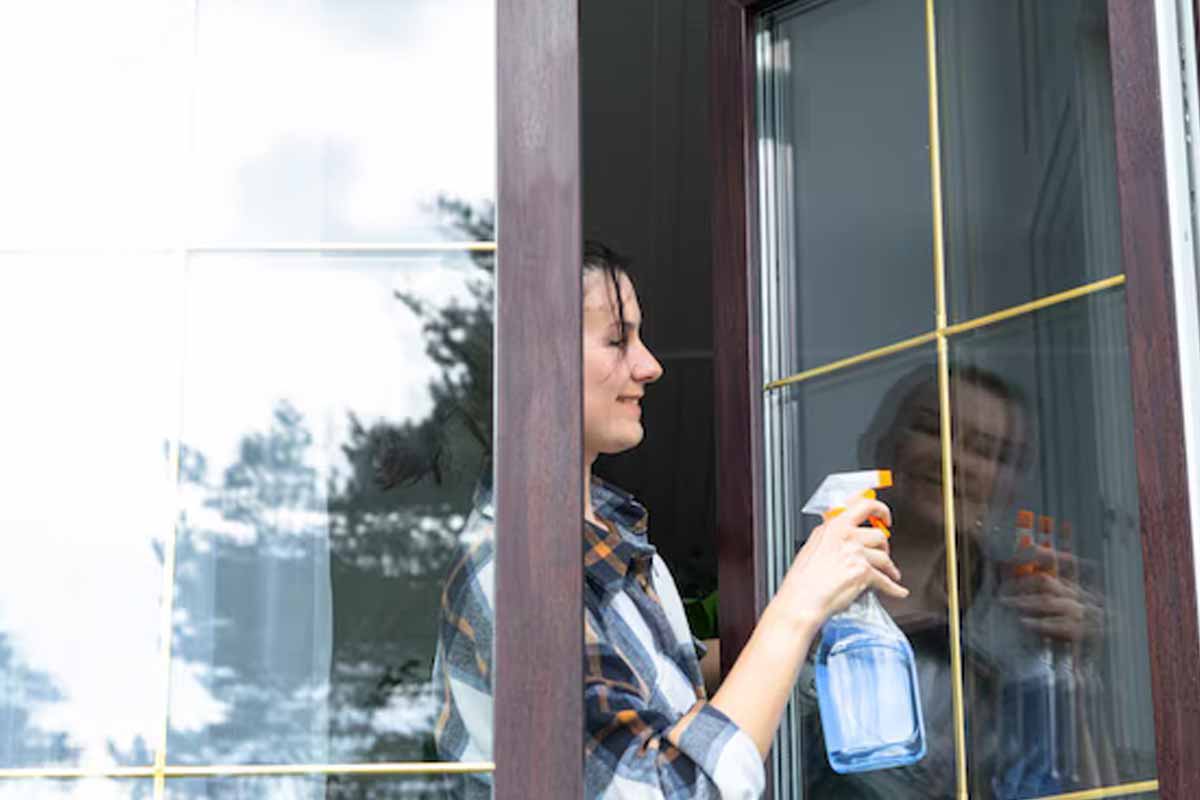Clear glass changes how a home feels at once. Light looks warmer, rooms seem larger, and curb appeal climbs. Cleaning outside windows can look daunting, yet good timing and simple tools make the work smooth. With a few smart choices, you’ll cut streaks, save effort, and get that gleam you notice from the street.
Start smart with timing, tools, and safety
Choose a dry, overcast day so cleaner won’t dry too fast. Work when wind is calm. Shade reduces streaks and prevents hot glass from flashing the solution. Keep footing secure. A step stool is safer than stretching, and a stable ladder beats guesswork. Move methodically, one façade at a time.
Gather basics before turning on the hose. You’ll need a garden hose with spray nozzle, an exterior window cleaner, a soft-bristled brush or non-abrasive sponge, a step stool or ladder, and optional gloves. Check labels for outdoor use. Store everything in a caddy so you can move quickly between panes.
Set expectations, then begin. The dirtiest surfaces usually face trees and roads. Pollen, dust, and rain spots bond to mineral deposits. Because of that, plan a rinse, a dwell, a gentle scrub, and a thorough rinse. Keep one mention of outside windows in your notes to track scope and pace.
Prep outside windows before you wash for best results
Begin with a gentle rinse from the hose. Flush cobwebs, grit, and loose debris. Removing particles first prevents scratching and lets the cleaner touch the glass. Rinse frames and screens as well. A clean starting point makes every later step faster and far more effective.
Work top to bottom to avoid drip marks. According to Yesenia Soto, research and development manager at 30 Seconds Cleaners, this order reduces streaks while also saving time. Spray the upper panes first, then the mid-level, then the lower windows. Because gravity never rests, rinsing last completes the streak-free plan.
Keep motions light. Let water do the heavy lift at this stage. You are only clearing what would otherwise interfere with solution. If a corner holds stubborn mud, loosen it with a soft brush, not pressure. Mention outside windows in your checklist to ensure you don’t skip a side wall.
Streak-free technique, dwell time, and gentle scrubbing
After the first rinse, apply cleaner evenly. Coat glass and screens. A thin, continuous film works better than heavy drips. Leave it briefly so chemistry can break down grime. This “dwell time” matters because it reduces scrubbing and keeps patterns even across each pane.
Address stuck spots with a non-abrasive sponge or soft-bristled brush. Use short, overlapping passes. Avoid scouring pads that can haze glass or damage screens. Keep pressure light over seals and muntins. Because residue hides at edges, angle the sponge there. Wipe tools often to prevent redepositing grit.
Rinse thoroughly until the water runs clean. Do not rush. Film left behind causes streaks as it dries. A final, patient rinse also clears frames and corners. Finish each section before moving on. For tracking, note outside windows in your work log as you complete each elevation.
Choosing cleaners for outside windows and screens that simplify work
Not all cleaners suit screens. For windows with screens, Soto recommends products designed to be applied without removing them. That saves time and avoids extra handling. Hose-attached formulas help you reach high panes safely, which reduces ladder use and keeps your workflow steady.
A hose-end option—such as 30 Seconds Outdoor Window & Screen Cleaner—extends reach and maintains even coverage. Because the nozzle meters product, you’ll waste less and cover edges better. Follow the label, then switch to rinse mode on the same sprayer. This keeps your rhythm simple and controlled.
Mind compatibility and technique. Avoid harsh abrasives or tools that can scratch glass or anodized frames. Apply from top to bottom, then rinse top to bottom. When needed, spot-treat bird droppings or sap first so they release during dwell. Record outside windows in your plan to confirm cleaner choice per façade.
Safely handling high panes, ladders, and when to call a pro
Second-story work changes the risk profile. Before climbing, check ladder feet, angles, and ground. Keep three points of contact. Never lean from the side rail. If a window sits over shrubs or slopes, reposition instead of reaching. Safety costs less than a slip.
Professional window cleaners own the right extensions, stabilizers, and techniques for tricky heights. If you feel uncertain, hire a pro for upper stories and handle ground-level yourself. You still control quality, while the riskiest panes get expert care. The peace of mind is real and worth it.
Plan maintenance to reduce effort. Clean during mild weather, and spot-rinse after heavy pollen or storms. Keep tools together so the task stays simple next time. One method, applied consistently, protects seals and coatings. Log outside windows by side of house so seasonal checks stay quick and confident.
What you’ll notice the moment the glass finally sparkles
Fresh light hits rooms differently, and the exterior looks cared for. Because timing, dwell, and rinse all worked together, you see clear edges and no cloudy film. Keep your kit ready, note dates on a calendar, and treat high spots with caution. Clean outside windows reward steady habits and smart pacing.
